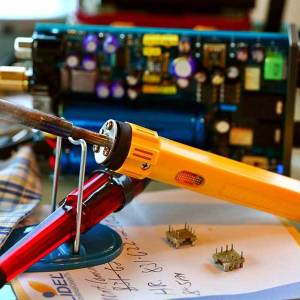The need to solder something at home often occurs even in people who have never held a tool specifically designed for such a task. How to deal with small problems, like torn wiring or falling parts, without a soldering iron?
How to solder without a soldering iron - simple ways to solder wires
The soldering iron for connecting metal parts is desirable, but not necessarily. To do without it, we will take:
- small metal container;
- solder, for example, brands POST, can be used pure tin;
- rosin.
Next, we act in this way:
- We connect the wires: first we clean them, removing the insulation by 2-3 cm.
- We heat the container with rosin and tin (for example, on a gas stove or by means of a burner).
- We lower the ends of the wire without insulation into molten rosin (immerse so that the composition completely covers the entire surface), and then into the molten metal. It is advisable not to gain excess tin, or remove it immediately after extracting.
- Copper wires, with a diameter of up to 0.75 mm², are simply twisted with each other after a pout.
- Next, the “problem” area is heated again so that the solder grabs. It will have to heat it with some narrow-minded tool: a candle, a lighter, etc.
- If you need to attach one segment of the wire to the middle of the other, its bare part is wound around the junction, and then the soldering is carried out.

How to solder parts and dishes without a soldering iron
To carry part of the flat surface for subsequent soldering, small tin chips and a little rosin are placed on it. The source of fire is placed from below, and when the solder melts, it is carefully rubbed with any suitable metal part (you can also remove excess). During the pile of the steel part, rosin is not used (its functions are treated with soldering acid). To solder aluminum items, you need a special solder consisting of tin and lead.

Other cases of soldering without a soldering iron
A little more complex cases of connecting parts require a special approach. For example:
- When working with large, multi -core wires (up to 2 mm), tin miles may not be enough for reliable adhesion. On top of the twist, pour a crushed solder and warm it until the particles melt and get inside, filling the slightest gaps.
- To solder the wire to the part: we pour the surface of both objects. Then we press the wire to the plane, pour the sprinkle chips on top and heat from the bottom until the moment of melting.
- Soldering of wires up to 3 mm: can be made without a soldering iron, using a gutter method. The latter must be made of aluminum foil, whose thickness will be about 0.8 mm. The ends of the wires are twisted and folded in parallel, a gutter is located around them, whose width does not exceed the size of the connected area. Caniphol and solder are poured into it, one end of the foil is twisted so as not to scatter the components. The desired section of the foil under the wires is heated to melting, and then it is untwisted and separated.

Another common method of soldering without a soldering iron is the use of the so -called “cold welding” or various soldering pastes that can be bought or made manually.






























